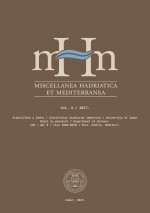Hagiotoponimi na istarskim gradinama
Hagiotoponyms on the hill forts of Istria
Author(s): Klara Buršić-MatijašićSubject(s): Christian Theology and Religion, Historical Linguistics, Prehistory
Published by: Sveučilište u Zadru
Keywords: Istria; prehistory; hill forts; hagiotoponyms;
Summary/Abstract: Place names (toponyms) are reflections of landscape appearance, economy, historical development and social relations. They speak of stratification of settlements of a certain territory. During the Bronze and Iron Ages in Istria, hill forts were ‒ in addition to caves ‒ the main settlement type. Up to now, 450 hill forts are identified on the map, and 85 of these (i.e., 19%) are named after saints. On the basis of field research and data from both historical and contemporary topographic maps, a detailed topographical layout of toponyms and an analysis of their distribution have been made in relation to two main physical features, sea and land, and two linguistic areas, Croatian and Italian. Small churches, or their remains, or just the toponyms with names of saints, show the continuity of life in a particular site, as well as the security that was guaranteed within its walls. The most frequent hagiotoponym is St Mary with all of its variants (Sv. Marina [St Marina]).
Journal: Miscellanea Hadriatica et Mediterranea
- Issue Year: 2017
- Issue No: 4
- Page Range: 111-135
- Page Count: 25
- Language: English, Croatian

